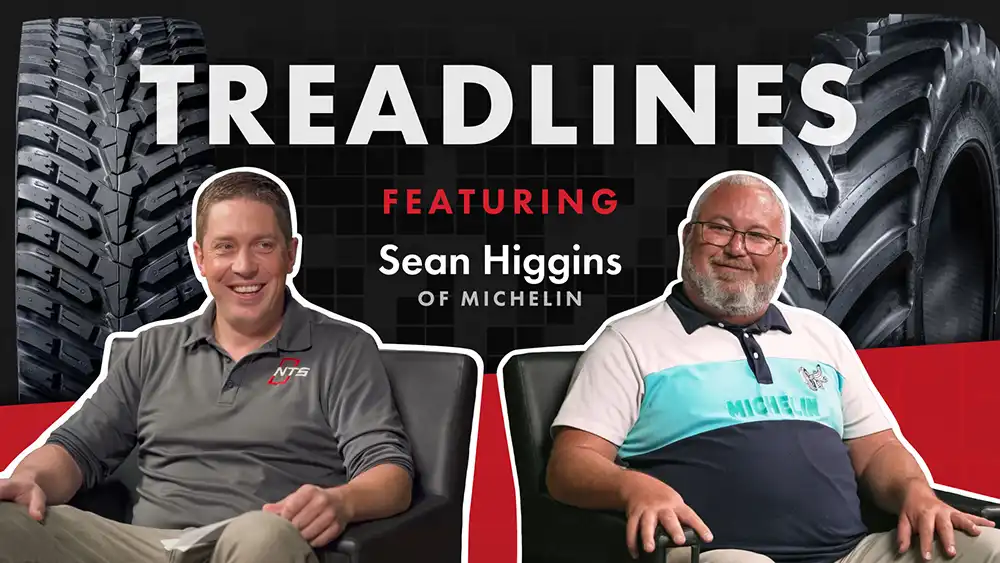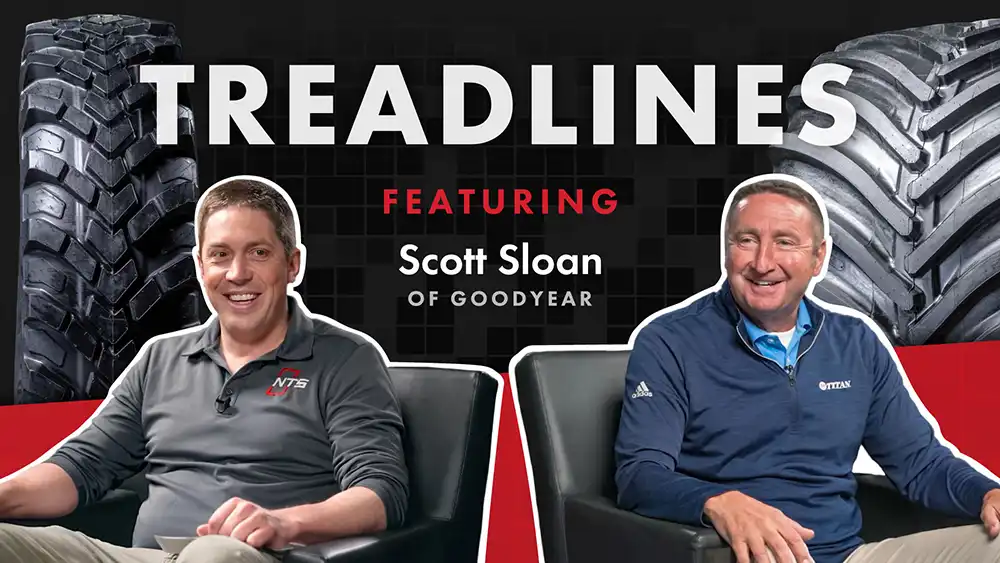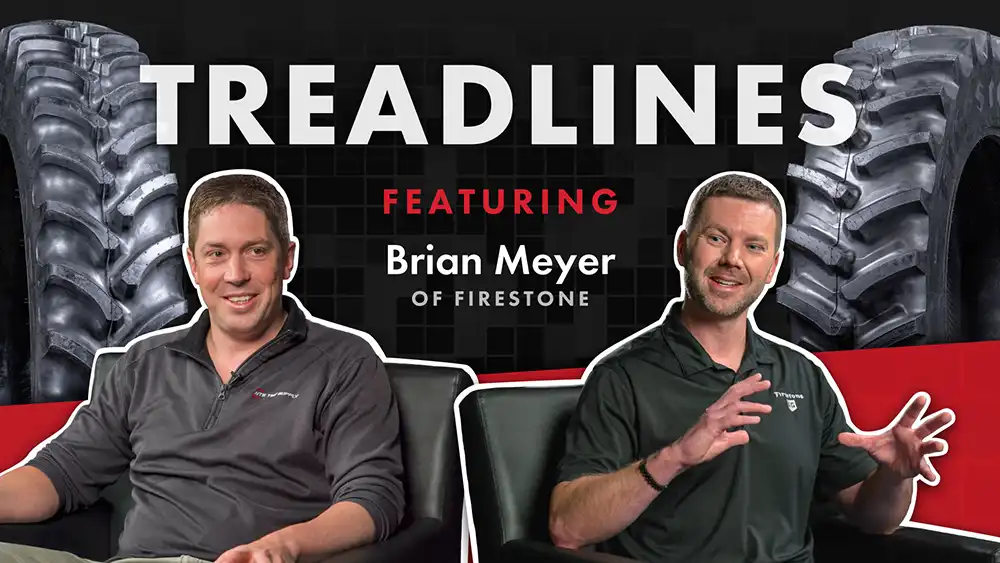A tire’s load and speed ratings are easy to miss. Those funny number/letter combinations on a tire’s sidewall don’t exactly grab your attention. And reading through a tire manufacturer’s data book to translate them into actual limits probably isn’t top on your to-do list. But if you totally ignore the load and speed ratings of your machine’s tire setup, you could be setting yourself up for lost productivity and frustration.

The Many Risks of Ignoring Your Tires’ Limits
Greek or not, you or your tire shop need to speak the language of load and speed indexes if you want to keep your farm moving forward. If you equip your machine with tires that are packing a load or speed index that isn’t high enough for the tasks at hand, you could set yourself up for:
- A total tire failure.
- Fast or uneven tire wear.
- Poor road & field performance.
- Accidents such as spills or rollovers.
- Unsafe conditions for you or your employees.
In other words, if you outfit your equipment with the wrong tires and wheels, you’re risking everything from wasted time to serious injuries.
Overloading is Bad. And so is Underloading Your Tires.
It’s never a good day when your farm is at a standstill because of a tire failure. If you’re expecting your tires to carry more weight—or run faster—than they were designed for, your tires can sustain casing damage from excessive heat buildup or stress cracking. As we mentioned above, the result can range from frustrating to downright dangerous.
However, the solution isn’t to “over-tire” your machine. Radial tires need to have enough load on them to operate as designed—to flex their sidewalls to put down large, stable footprints. Underloading your tires will also speed up tire wear, reduce traction, and potentially increase compaction problems in the field.
Read More: Learn why larger tire footprints boost your yields and save you time and money.
The Top 2 Strategies for Choosing the Right Load and Speed Index for Your Farm Tires
Use Your Machine’s Real-World Specs
In order to choose the best farm tires for your machine, you need to have a realistic idea of its actual loaded weight and the speed at which you intend to operate it. You don’t want to look up the factory weight of the machine and call it good. What about those saddle tanks for spray or ballast you’ve added to your row crop tractor? Or the extra fertilizer tanks you’ve mounted on your planter? How heavy is the rear axle of your tractor with a folder-up planter attached? Maybe your ripper’s tires have to survive 10- or 20-mile trips down the highway between tillage jobs. Or, maybe you’ve added a larger head and hopper extension to your combine. (More on that one in a bit.) You get the idea: there are a dozen different modifications that render a machine’s factory weight specifications useless.
Talk to the Farm Tire Experts at NTS Tire Supply
These days, manufacturers do a decent job of properly outfitting machines direct from the factory with appropriate tire and wheel packages that safeguard your farm’s productivity. Fendt’s Momentum planter, for example, comes standard from the factory with VF-rated radials and a central tire inflation system to minimize compaction in the field by varying the tire pressure based on the planter’s speed and weight.
However, for older machines—or if you’re experiencing performance problems or a total tire failure on a particular machine—it pays to contact the tire experts at NTS Tire Supply. For example, we field calls every fall from farmers with failed combine wheels or tires, which have brought harvest to a complete standstill on their farms. Often, these tire and wheel packages are simply overloaded because the farmers are no longer running factory combines. After all, it’s hard to resist a wider head and hopper extension. But if you add these goodies, you probably need to beef up your tires and wheels to handle the extra maximum weight.
Give NTS Tire Supply a call and we’ll help you review your machine’s tire setup if you’re experiencing any of these problems:
- Tire failures.
- Fast or uneven tire wear.
- Rutting/compaction in the field.
- Slow working speeds (poor traction).
- Power hop or road lope.
How to Read Tire Load and Speed Indexes
Letters for Speed
We’ll deal with speed first, as it’s the easiest to understand. A letter represents the speed symbol, which generally appears behind a tire’s load rating on the sidewall. A8 (25 mph), B (31 mph), and D (40 mph) are three of the most common speed ratings you’ll find in agricultural tires.
A tire’s speed rating has increased in importance over the years for two reasons: One, farmers are traveling greater distances between fields and the tires are exposed to tire-cooking road travel for longer periods. Two, the machines are traveling at higher speeds.
Numbers for Load
The numbers used to relate a tire’s load rating may seem nonsensical, but they are standardized by the Tire and Rim Association. The higher the number, the more load the tire can carry. You can bookmark our load index chart for future reference, view it below, or you’ll generally find a similar chart in any manufacturer’s tire data book.

Duals Don’t Double Your Capacity!
Let’s say your MFWD tractor’s rear axle is fitted with 480/80R46 duals that carry a load and speed rating of 158A8. If you check the charts, you’ll see that each tire is rated to carry 9,350 pounds at a maximum speed of 25 miles per hour. So, with 4 tires, that axle is rated to carry 37,400 pounds, right?
Not quite. Duals increase the load carrying capacity of a tire setup by 1.76 times; duals don’t double your capacity. Using this math, you’ll see that the rear axle with four 480s is rated to carry 32,912 pounds, not 37,400 pounds.
Triples increase the load carrying capacity of a tire setup by 2.4 times. (So you can’t just multiply the capacity of a single tire by 6 to get that axle’s total load capacity.) Using the same example, the triple tire setup on our MFWD tractor would be rated for 44,880 pounds, not 56,100 pounds.
Respect Your Tires’ Limits and Drive Your Farm Forward
Frustrated by tire failures, fast tire wear, or other problems such as poor traction and slow working speeds? Then it’s time to review the tire setup that’s causing the concern. Contact the tire experts at NTS Tire Supply and we’ll work together to review your problem machine’s tire setup and come up with a solution that will Drive Your Farm Forward.

.png)
.jpg)



















